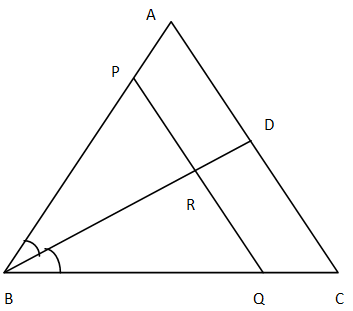
Answer
501.6k+ views
Hint: - The problem can be solved easily using the Intercept theorem.
Given $\vartriangle ABC$ in which $BD$ is the bisector of$\angle B$ and a line $PQ\parallel AC$meets $AB,BC$ and $BD$ at $P,Q$ and $R$ respectively.
For proof \[\left( i \right)\]
Considering small $\vartriangle BQP,BR$ is the bisector of$\angle B$.
Using the properties of similar triangles we have
$
\therefore \dfrac{{BQ}}{{BP}} = \dfrac{{QR}}{{PR}} \\
\Rightarrow BQ.PR = BP.QR \\
\Rightarrow PR.BQ = QR.BP \\
$ (Rearranging the terms amongst themselves)
For proof \[\left( {ii} \right)\]
In$\vartriangle ABC$ we have
$PQ\parallel AC$ (Given in the question)
$
\Rightarrow \dfrac{{AB}}{{AP}} = \dfrac{{CB}}{{CQ}} \\
\Rightarrow AB \times CQ = CB \times AP \\
\Rightarrow AB \times CQ = BC \times AP \\
$ (By using intercept theorem and then rearranging the terms)
Note: - The intercept theorem, also known as Thale’s theorem or basic proportionality theorem, is an important theorem in elementary geometry about the ratios of various line segments that are created if two intersecting lines are intercepted by a pair of parallels. In order to use the Intercept theorem, the first and foremost thing is to recognize the triangle correctly.
Given $\vartriangle ABC$ in which $BD$ is the bisector of$\angle B$ and a line $PQ\parallel AC$meets $AB,BC$ and $BD$ at $P,Q$ and $R$ respectively.
For proof \[\left( i \right)\]
Considering small $\vartriangle BQP,BR$ is the bisector of$\angle B$.
Using the properties of similar triangles we have
$
\therefore \dfrac{{BQ}}{{BP}} = \dfrac{{QR}}{{PR}} \\
\Rightarrow BQ.PR = BP.QR \\
\Rightarrow PR.BQ = QR.BP \\
$ (Rearranging the terms amongst themselves)
For proof \[\left( {ii} \right)\]
In$\vartriangle ABC$ we have
$PQ\parallel AC$ (Given in the question)
$
\Rightarrow \dfrac{{AB}}{{AP}} = \dfrac{{CB}}{{CQ}} \\
\Rightarrow AB \times CQ = CB \times AP \\
\Rightarrow AB \times CQ = BC \times AP \\
$ (By using intercept theorem and then rearranging the terms)
Note: - The intercept theorem, also known as Thale’s theorem or basic proportionality theorem, is an important theorem in elementary geometry about the ratios of various line segments that are created if two intersecting lines are intercepted by a pair of parallels. In order to use the Intercept theorem, the first and foremost thing is to recognize the triangle correctly.
Recently Updated Pages
Fill in the blanks with suitable prepositions Break class 10 english CBSE

Fill in the blanks with suitable articles Tribune is class 10 english CBSE

Rearrange the following words and phrases to form a class 10 english CBSE

Select the opposite of the given word Permit aGive class 10 english CBSE

Fill in the blank with the most appropriate option class 10 english CBSE

Some places have oneline notices Which option is a class 10 english CBSE

Trending doubts
Fill the blanks with the suitable prepositions 1 The class 9 english CBSE

How do you graph the function fx 4x class 9 maths CBSE

When was Karauli Praja Mandal established 11934 21936 class 10 social science CBSE

Which are the Top 10 Largest Countries of the World?

What is the definite integral of zero a constant b class 12 maths CBSE

Why is steel more elastic than rubber class 11 physics CBSE

Distinguish between the following Ferrous and nonferrous class 9 social science CBSE

The Equation xxx + 2 is Satisfied when x is Equal to Class 10 Maths

Differentiate between homogeneous and heterogeneous class 12 chemistry CBSE





